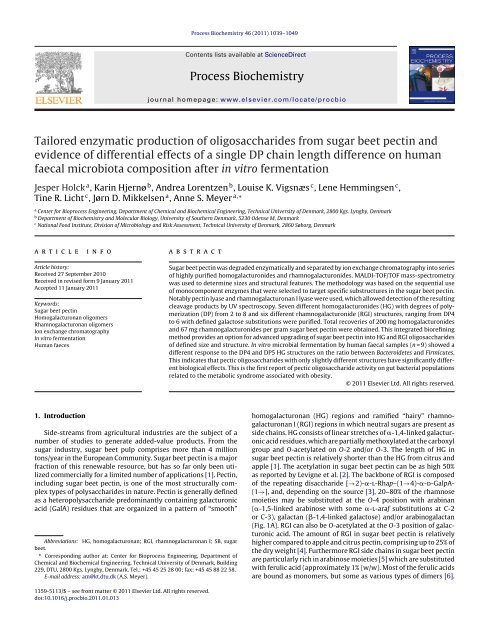Role of Intestinal Microbiota in Ulcerative Colitis
Role of Intestinal Microbiota in Ulcerative Colitis
Role of Intestinal Microbiota in Ulcerative Colitis
Create successful ePaper yourself
Turn your PDF publications into a flip-book with our unique Google optimized e-Paper software.
Process Biochemistry 46 (2011) 1039–1049<br />
Contents lists available at ScienceDirect<br />
Process Biochemistry<br />
journal homepage: www.elsevier.com/locate/procbio<br />
Tailored enzymatic production <strong>of</strong> oligosaccharides from sugar beet pect<strong>in</strong> and<br />
evidence <strong>of</strong> differential effects <strong>of</strong> a s<strong>in</strong>gle DP cha<strong>in</strong> length difference on human<br />
faecal microbiota composition after <strong>in</strong> vitro fermentation<br />
Jesper Holck a , Kar<strong>in</strong> Hjernø b , Andrea Lorentzen b , Louise K. Vigsnæs c , Lene Hemm<strong>in</strong>gsen c ,<br />
T<strong>in</strong>e R. Licht c , Jørn D. Mikkelsen a , Anne S. Meyer a,∗<br />
a Center for Bioprocess Eng<strong>in</strong>eer<strong>in</strong>g, Department <strong>of</strong> Chemical and Biochemical Eng<strong>in</strong>eer<strong>in</strong>g, Technical University <strong>of</strong> Denmark, 2800 Kgs. Lyngby, Denmark<br />
b Department <strong>of</strong> Biochemistry and Molecular Biology, University <strong>of</strong> Southern Denmark, 5230 Odense M, Denmark<br />
c National Food Institute, Division <strong>of</strong> Microbiology and Risk Assessment, Technical University <strong>of</strong> Denmark, 2860 Søborg, Denmark<br />
article <strong>in</strong>fo<br />
Article history:<br />
Received 27 September 2010<br />
Received <strong>in</strong> revised form 9 January 2011<br />
Accepted 11 January 2011<br />
Keywords:<br />
Sugar beet pect<strong>in</strong><br />
Homogalacturonan oligomers<br />
Rhamnogalacturonan oligomers<br />
Ion exchange chromatography<br />
In vitro fermentation<br />
Human faeces<br />
1. Introduction<br />
abstract<br />
Side-streams from agricultural <strong>in</strong>dustries are the subject <strong>of</strong> a<br />
number <strong>of</strong> studies to generate added-value products. From the<br />
sugar <strong>in</strong>dustry, sugar beet pulp comprises more than 4 million<br />
tons/year <strong>in</strong> the European Community. Sugar beet pect<strong>in</strong> is a major<br />
fraction <strong>of</strong> this renewable resource, but has so far only been utilized<br />
commercially for a limited number <strong>of</strong> applications [1]. Pect<strong>in</strong>,<br />
<strong>in</strong>clud<strong>in</strong>g sugar beet pect<strong>in</strong>, is one <strong>of</strong> the most structurally complex<br />
types <strong>of</strong> polysaccharides <strong>in</strong> nature. Pect<strong>in</strong> is generally def<strong>in</strong>ed<br />
as a heteropolysaccharide predom<strong>in</strong>antly conta<strong>in</strong><strong>in</strong>g galacturonic<br />
acid (GalA) residues that are organized <strong>in</strong> a pattern <strong>of</strong> “smooth”<br />
Abbreviations: HG, homogalacturonan; RGI, rhamnogalacturonan I; SB, sugar<br />
beet.<br />
∗ Correspond<strong>in</strong>g author at: Center for Bioprocess Eng<strong>in</strong>eer<strong>in</strong>g, Department <strong>of</strong><br />
Chemical and Biochemical Eng<strong>in</strong>eer<strong>in</strong>g, Technical University <strong>of</strong> Denmark, Build<strong>in</strong>g<br />
229, DTU, 2800 Kgs. Lyngby, Denmark. Tel.: +45 45 25 28 00; fax: +45 45 88 22 58.<br />
E-mail address: am@kt.dtu.dk (A.S. Meyer).<br />
1359-5113/$ – see front matter © 2011 Elsevier Ltd. All rights reserved.<br />
doi:10.1016/j.procbio.2011.01.013<br />
Sugar beet pect<strong>in</strong> was degraded enzymatically and separated by ion exchange chromatography <strong>in</strong>to series<br />
<strong>of</strong> highly purified homogalacturonides and rhamnogalacturonides. MALDI-TOF/TOF mass-spectrometry<br />
was used to determ<strong>in</strong>e sizes and structural features. The methodology was based on the sequential use<br />
<strong>of</strong> monocomponent enzymes that were selected to target specific substructures <strong>in</strong> the sugar beet pect<strong>in</strong>.<br />
Notably pect<strong>in</strong> lyase and rhamnogalacturonan I lyase were used, which allowed detection <strong>of</strong> the result<strong>in</strong>g<br />
cleavage products by UV spectroscopy. Seven different homogalacturonides (HG) with degrees <strong>of</strong> polymerization<br />
(DP) from 2 to 8 and six different rhamnogalacturonide (RGI) structures, rang<strong>in</strong>g from DP4<br />
to 6 with def<strong>in</strong>ed galactose substitutions were purified. Total recoveries <strong>of</strong> 200 mg homogalacturonides<br />
and 67 mg rhamnogalacturonides per gram sugar beet pect<strong>in</strong> were obta<strong>in</strong>ed. This <strong>in</strong>tegrated bioref<strong>in</strong><strong>in</strong>g<br />
method provides an option for advanced upgrad<strong>in</strong>g <strong>of</strong> sugar beet pect<strong>in</strong> <strong>in</strong>to HG and RGI oligosaccharides<br />
<strong>of</strong> def<strong>in</strong>ed size and structure. In vitro microbial fermentation by human faecal samples (n = 9) showed a<br />
different response to the DP4 and DP5 HG structures on the ratio between Bacteroidetes and Firmicutes.<br />
This <strong>in</strong>dicates that pectic oligosaccharides with only slightly different structures have significantly different<br />
biological effects. This is the first report <strong>of</strong> pectic oligosaccharide activity on gut bacterial populations<br />
related to the metabolic syndrome associated with obesity.<br />
© 2011 Elsevier Ltd. All rights reserved.<br />
homogalacturonan (HG) regions and ramified “hairy” rhamnogalacturonan<br />
I (RGI) regions <strong>in</strong> which neutral sugars are present as<br />
side cha<strong>in</strong>s. HG consists <strong>of</strong> l<strong>in</strong>ear stretches <strong>of</strong> �-1,4-l<strong>in</strong>ked galacturonic<br />
acid residues, which are partially methoxylated at the carboxyl<br />
group and O-acetylated on O-2 and/or O-3. The length <strong>of</strong> HG <strong>in</strong><br />
sugar beet pect<strong>in</strong> is relatively shorter than the HG from citrus and<br />
apple [1]. The acetylation <strong>in</strong> sugar beet pect<strong>in</strong> can be as high 50%<br />
as reported by Levigne et al. [2]. The backbone <strong>of</strong> RGI is composed<br />
<strong>of</strong> the repeat<strong>in</strong>g disaccharide [→2)-�-l-Rhap–(1→4)-�-d-GalpA-<br />
(1→], and, depend<strong>in</strong>g on the source [3], 20–80% <strong>of</strong> the rhamnose<br />
moieties may be substituted at the O-4 position with arab<strong>in</strong>an<br />
(�-1,5-l<strong>in</strong>ked arab<strong>in</strong>ose with some �-l-araf substitutions at C-2<br />
or C-3), galactan (�-1,4-l<strong>in</strong>ked galactose) and/or arab<strong>in</strong>ogalactan<br />
(Fig. 1A). RGI can also be O-acetylated at the O-3 position <strong>of</strong> galacturonic<br />
acid. The amount <strong>of</strong> RGI <strong>in</strong> sugar beet pect<strong>in</strong> is relatively<br />
higher compared to apple and citrus pect<strong>in</strong>, compris<strong>in</strong>g up to 25% <strong>of</strong><br />
the dry weight [4]. Furthermore RGI side cha<strong>in</strong>s <strong>in</strong> sugar beet pect<strong>in</strong><br />
are particularly rich <strong>in</strong> arab<strong>in</strong>ose moieties [5] which are substituted<br />
with ferulic acid (approximately 1% (w/w). Most <strong>of</strong> the ferulic acids<br />
are bound as monomers, but some as various types <strong>of</strong> dimers [6].
















